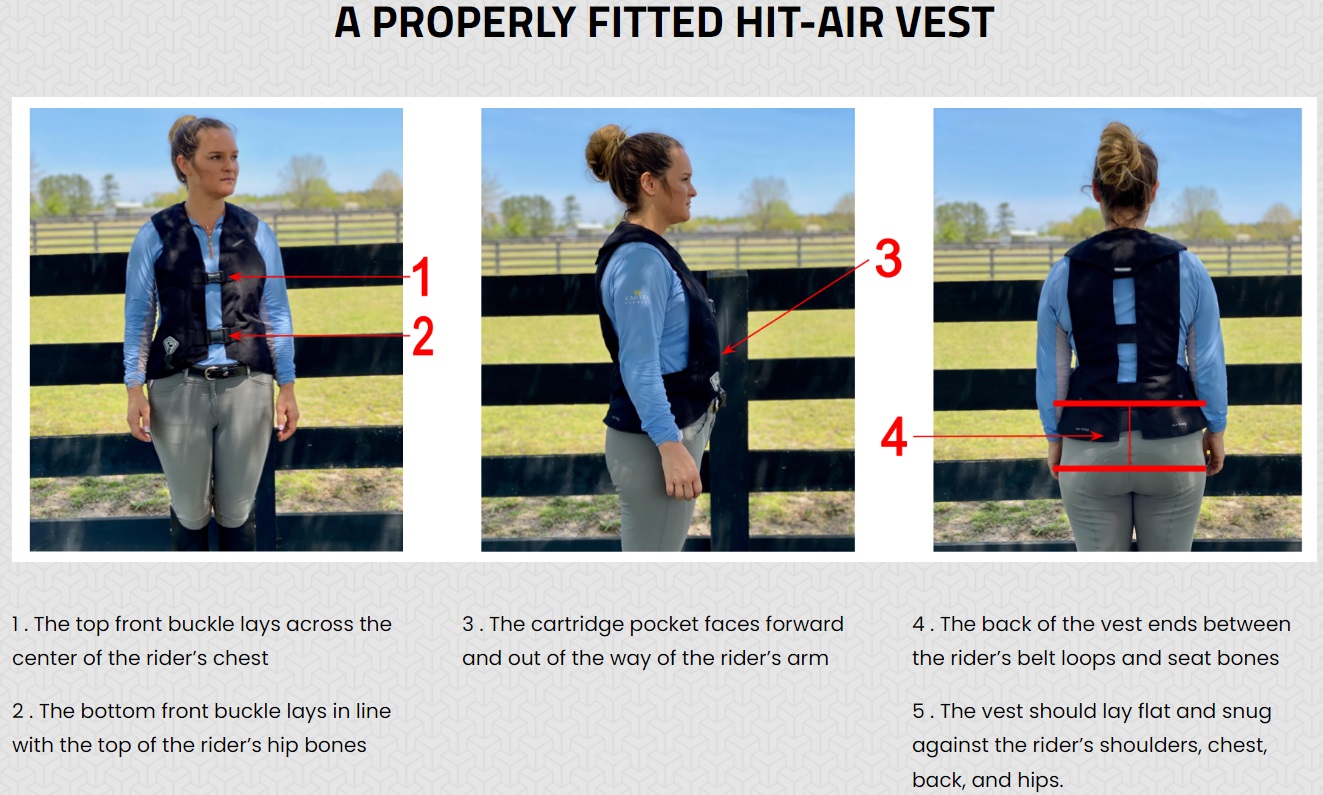Hit-Air Original Air Vest
The Hit Air Equestrian Light Airbag Vest is worn over your protective vest and inflates instantly in the event of a fall to give you an extra layer of protection from injury. This vest is highly recommended and worn by top riders. The Hit-Air Vest will instantly inflate in the event of a fall protecting the neck, torso, hips and spine using an innovative design with a high speed airbag deployment system that uses a CO2 cartridge to automatically inflate the vest in .25 seconds decreasing your chance of serious injury.
A bungee lanyard (included) is attached to both the saddle and the vest. Should the rider and the horse be separated, the lanyard pulls a "key" out of the CO2 cartridge to inflate the air cushion. The inflated vest absorbs the impact helping to prevent injury. You will hardly notice this super lightweight and comfortable vest even when worn over a riding vest (which is recommended).
This harness type airbag employs the new higher speed key ball mechanism (component that activates the CO2 cartridge). It is quiet when deployed, making it much less likely to spook the horse during an unintended deployment.
- New high speed airbag deployment system
- Recommended for use over a Body Protector
- Uses 48cc cartridge
- Optional Saddle strap attaches to the stirrup bars and is highly recommended. Saddle D rings could detach when pulled resulting in the vest's failure to inflate.
- Lightweight and provides total freedom of movement - 1.76 pounds for the XXS to SM and 1.9 pounds for the M to XL
- Comes complete with 1 cartridge and lanyard to attach to saddle
This Product can ship by ground only*
Sizing:
- XXS to Small (chest 29"-37", waist 23"-31")
- Medium to XL (chest 37"-49", waist 30"-42")
*Due to Federal Regulations, CO2 cartridges are non-returnable.
| Brand | Hit Air |
|---|---|
| MPN | LV/SV |
| Sale Type | Regular Price Items |
| SKU | 201779 |
Safety Vest Certification Organizations
BETA

BETA maintains the EN equestrian standards
EN 13158 is a body protector standard with three primary components
- Specifies the area of the body that must be covered
- Tests impact performance both on flat ground and fence rails
- Measures security of attachment to the wearer
Impact testing is conducted at ambient temperatures, and an optional 30°C impact test is also available.
Body protector manufacturers conforming to the BETA standards are required to annually re-test their approved products to ensure ongoing consistency in the quality of manufacture and of the shock-absorbing foams used in the construction of their garments.
SEI (ASTM)

SEI maintains ASTM standards
ASTM F1937 is a standard that specifies:
- Requirements for the body protector assembly
- The extent and form of the protective material used
- The attachments
- The dimension, sizing and body coverage provided
Testing procedures include a shock attenuation test, a penetration and deformation test, an impact sites test, a padding separation test, and a closure test.
These tests are done in four conditions: ambient temperature, low temperature, high temperature, and water immersion.
ASTM F2681 is a standard for body protectors that covers the minimum performance criteria and outlines test methods for body protectors that will be used specifically for horse racing.
Levels of Protection

In 1995, BETA Level 1, 2, and 3 safety standards were introduced, with 1 being the lowest and 3 being the highest level of protection offered.
There are three levels of protection to cater for different riding activities. The latest European safety standard is EN 13158 and BETA 2018.
No body protector can prevent serious injury in certain accidents, but you can improve your chances of staying safe by choosing the highest safety standard.
Level 1 (green label)
Body protectors certified to Level 1 provide a lower level of impact protection that is only considered appropriate for racing where weight is of over-riding importance and there are no requirements in place for a great level of protection.
Level 2 (orange label)
Body protectors certified to Level 2 provide a lower than normal level of protection that is only considered appropriate for use in low risk situations.
These DO NOT include riding on roads or other hard surfaces, riding over jumps, riding young or excitable horses or riding while inexperienced. This level is now used by many jockeys while racing.
Level 3 (blue label)
Body protectors certified to Level 3 provide a level of protection that is considered appropriate for normal horse riding, competitors and for working with horses.
Protectors to this level should prevent minor bruising that would have produced stiffness and pain, reduce soft tissue injuries and bruising, and prevent a limited number of rib fractures.
This level is required by many exercise riders for race horses.
Level 3 – Carriage driving (blue label)
Body protectors designed to meet the needs of horse drivers. Navigators are best wearing a standard level 3. It does not provide adequate coverage of the back for those riding horses or those working with them.



Customer Reviews
recommend this product



Other Popular Products


















